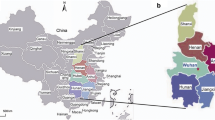Abstract
Objective
To investigate the etiology of bacterial enteropathogens causing diarrhea among children; to elucidate the risk factors, sign and symptoms involved in developing of infection; and to identify the antimicrobial susceptibility pattern.
Methods
Stool samples from diarrheal cases with clinical diagnosis of gastroenteritis compared to matched controls, were examined for detection of bacterial enteropathogens by conventional cultural method from February 2006 through January 2007.
Results
Ninety three of diarrheal cases comprising enteropathogen isolates. A recognized bacterial enteric pathogen was identified in 31% of the cases and 8% of the control group. The frequency of isolated enteropathogens from faeces of diarrheal cases was recorded in the following order, Enterohemorrhagic E. coli 8.3%, Shigella spp. 6.7%, Campylobacter jejuni 5%, Salmonella spp. 4%, Yersinia enterocolitica 2.7%, Aeromonas spp. 4.7%, and Plesiomonas spp. 1.3%. E.H.E coli, Shigella and Salmonella had shown a significant statistical association with diarrhea (p < 0.05). Compared to matched uninfected control, multivariate analysis revealed that malnutrition status (OR adjusted 8.37; p < 0.001) was the only independent factor associated with infection. Antibiotic susceptibility profile indicated that enteropathogens were generally susceptible to meropenem, ceftriaxone, followed by amikacin and ciprofloxacin. Almost all enterpathogens were resistant to ampicillin and amoxicillin.
Conclusions
The results of this study emphasize the importance of bacterial enteropathogens in causing severe diarrhea in children. E.H.E. coli was the most predominant pathogen. Malnutrition was identified as the main independent risk factor associated with developing of infection. Ampicillin and amoxicillin should not be used as empirical treatment in acute diarrhea.

Similar content being viewed by others
References
Jafari F, Shokrzadeh L, Hamidian M, Salmanzadeh-Ahrabi S, Zali MR. Acutediarrhea due to enteropathogenic bacteria in patients at hospitals in Tehran. Jpn J Infect Dis. 2008;61:269–73.
Samal SK, Khuntia HK, Nanda PK, et al. Incidence of bacterial enteropathogens among hospitalized diarrhea patients from Orissa, India. Jpn J Infect Dis. 2008;61:350–5.
Mandomando I, Jaintilal D, Pons MJ, et al. Antimicrobial susceptibility and mechanisms of resistance in Shigella and Salmonella isolates from children under 5 years of age with diarrhea in rural Mozambique. Antimicrob Agents Chemother. 2009;53:2450–4.
Nimri LF, Meqdam M. Enteropathogens associated with cases of gastroenteritis in a rural population in Jordan. Clin Microbiol Infect. 2004;10:634–9.
Vu Nguyen T, Le Van P, Le Huy C, Nguyen Gia K, Weintraub A. Etiology and epidemiology of diarrhea in children in Hanoi, Vietnam. Int J Infect Dis. 2006;10:298–308.
Tjaniadi P, Lesmana M, Subekti D, et al. Antimicrobial resistance of bacterial pathogens associated with diarrheal patients in Indonesia. Am J Trop Med Hyg. 2003;68:666–70.
Koletzko S, Osterrieder S. Acute infectious diarrhea in children. Dtsch Arztebl Int. 2009;106:539–47.
WHO. Manual for Laboratory Investigations of Acute Enteric Infections. Edited by the Diarrhoeal Disease Control Programme. Geneva: World Health Organization; 1987. pp. 1–113.
National Committee for Clinical Laboratory Standards. Performance Standards for Antimicrobial Susceptibility Testing. Document M7eA4. Villanova: PA: NCCLS; 1997.
Chisti MJ, Faruque AS, Khan WA, Das SK, Zabed MB, Salam MA. Characteristics of children with Shigella encephalopathy: experience from a large urban diarrhea treatment center in Bangladesh. Pediatr Infect Dis J. 2010;29:444–7.
Chompook P, Todd J, Wheeler JG, von Seidlein L, Clemens J, Chaicumpa W. Risk factors for shigellosis in Thailand. Int J Infect Dis. 2006;10:425–33.
Nielsen H, Hansen KK, Gradel KO, et al. Bacteraemia as a result of Campylobacter species: a population-based study of epidemiology and clinical risk factors. Clin Microbiol Infect. 2010;16:57–61.
Wang SC, Chang LY, Hsueh PR, et al. Campylobacter enteritis in children in northern Taiwan—a 7-year experience. J Microbiol Immunol Infect. 2008;41:408–13.
Surek M, Vizzotto BS, Souza EM, et al. Identification and antimicrobial susceptibility of Aeromonas spp. isolated from stools of Brazilian subjects with diarrhoea and healthy controls. J Med Microbiol. 2010;59:373–4.
Hilbert F, Mayrhofer S, Smulders FJ. Rapid urease screening of Yersinia on CIN agar. Int J Food Microbiol. 2003;84:111–5.
Albert MJ, Faruque AS, Faruque SM, Sack RB, Mahalanabis D. Case-control study of enteropathogens associated with childhood diarrhea in Dhaka, Bangladesh. J Clin Microbiol. 1999;37:3458–64.
Genser B, Strina A, Teles CA, Prado MS, Barreto ML. Risk factors for childhood diarrhea incidence: dynamic analysis of a longitudinal study. Epidemiology. 2006;17:658–67.
Acknowledgements
We acknowledge the support and assistance of all pediatricians, nurses and laboratory staff of El-Dorra pediatric, Shohdaa El-Aqsa, European Gaza and El-Naser hospitals, for their assistance and cooperation.
Author information
Authors and Affiliations
Corresponding author
Rights and permissions
About this article
Cite this article
Al Jarousha, A.M.K., El Jarou, M.A. & El Qouqa, I.A. Bacterial Enteropathogens and Risk Factors Associated with Childhood Diarrhea. Indian J Pediatr 78, 165–170 (2011). https://doi.org/10.1007/s12098-010-0249-0
Received:
Accepted:
Published:
Issue Date:
DOI: https://doi.org/10.1007/s12098-010-0249-0



